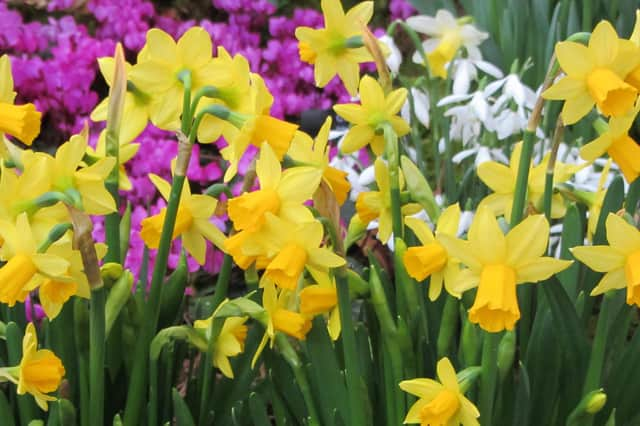Make winter colourful with these blooming plants | Gardening


We have been buying a few bulbs each week, not planting them yet as the garden still looks beautiful thanks to regular dead heading. The recent sun has transformed the flower border which is still attractive and almost as good as it was in July.
I thought it might be a good idea to suggest planting bulbs in pots and have in mind planting miniature bulbs to brighten an outdoor window sill if you don’t have a garden. Everyone loves snowdrops and we found a pack of 25 bulbs for £3.99.
Advertisement
Hide AdAdvertisement
Hide AdIf they were planted directly into the garden, birds will disturb them, the squirrels will eat them and only a few would survive, so normally we would buy them ‘in the green’ in winter.
However if they are planted now in clay pots, planting five around the pot’s edge, inserting the bulbs so there is an inch of compost over the tips of each bulb, they will flower in February. On a window sill it’s best to use John Innes No2 compost in clay pots. These are heavier than plastic and the wind won’t blow them over.
Another gem for tiny spaces is chionodoxa, or Glory of the Snow. It has star-like flowers and there are blue or pink varieties. If you like something no one else has, try the pink, five around the edge of a five-inch diameter pot. They flower in March.
Scilla is another little star with its nodding blue flowers. The flowers’ colour is enhanced by spreading silver sand over the compost’s surface to intensify the dark blue flower colour – a trick I learned as an apprentice. These are best grown in five-inch half-pots.
Advertisement
Hide AdAdvertisement
Hide AdIris reticulata is another delight. Look at the picture on the pack’s front to see if you prefer the light blue, mid-blue or perhaps the variety Cantab, a pale blue with a lighter centre and a hint of yellow.
If you like daffodils and live in a windy spot, plant short varieties.
Tete a Tete has several blooms on each stem and looks great when planted leaving only half an inch between each bulb. If you are short of space plant them in two layers in a container. Use a piece of broken clay pot over each hole in the base with a four inch layer of John Innes No2 compost and then the layer of bulbs. Cover with the compost so there’s a two-inch layer of compost over the tops then plant another batch.
When they flower in spring, the container will be a mass of colour. Don’t plant mixed, try Tete a Tete and you will be delighted.
Advertisement
Hide AdAdvertisement
Hide AdJetfire is another beauty. This has an orange trumpet and can be planted in the same way. If you would like to cover the surface of the container with flowers allt hrough winter, try erica carnea – the winter-flowering heather. They normally flower from December until spring.
I love erica vivellii best, it’s a bright red one but difficult to find. That bright red with yellow daffs is something to look forward to!
Jobs for the weekend
:: Reduce the water given to cacti and dust off the pads with a small paint brush to smarten them up.
:: Take cuttings of zonal pelargoniums (geraniums) which root well at this time. Cuttings need to be about five inches long. Remove any flowers and flower buds leaving just the top two leaves and growing tip. Make a sharp cut below a node and insert into a sandy compost. Don’t over-water.
Advertisement
Hide AdAdvertisement
Hide Ad:: Try to remove chickweed before it flowers otherwise it will cover the soil inwinter. Put these weeds in the compost bin.
:: Azaleas in pots should now be taken indoors. Clean the plants and give them a good shake to remove dead leaves. They always lose some leaves when initially brought back indoors. Save rainwater for watering the pots.
:: Amaryllis leaves should have died back by now. If not, cut all the leaves off and repot in John Innes No3 compost but no water until you see the flower bud next year.
Questions and answers
Q: My son sent me a beautiful bouquet for my birthday and there is a yellow spray chrysanthemum among the blooms. There is a strong shoot growing from the base of the stem and I would like to root this. Is it possible please? DK, Baffins.
Advertisement
Hide AdAdvertisement
Hide AdA: Yes. The cutting needs to be about four inches long. Cut below a leaf joint (node). Take off all the leaves apart from the top pair and the growing tip and insert into compost adding 50 per cent extra sand.Keep indoors in the shade and it will root in about four weeks.
Q: I found a container of creosote substitute which has been buried in the shed for more than 10 years. Is it safe to use? DK, Rowlands Castle.
A: Yes. Excellent for preserving fences etc but never allow it to touch shrubs or flowering plants as it will either damage or kill them. Never apply with a sprayer.